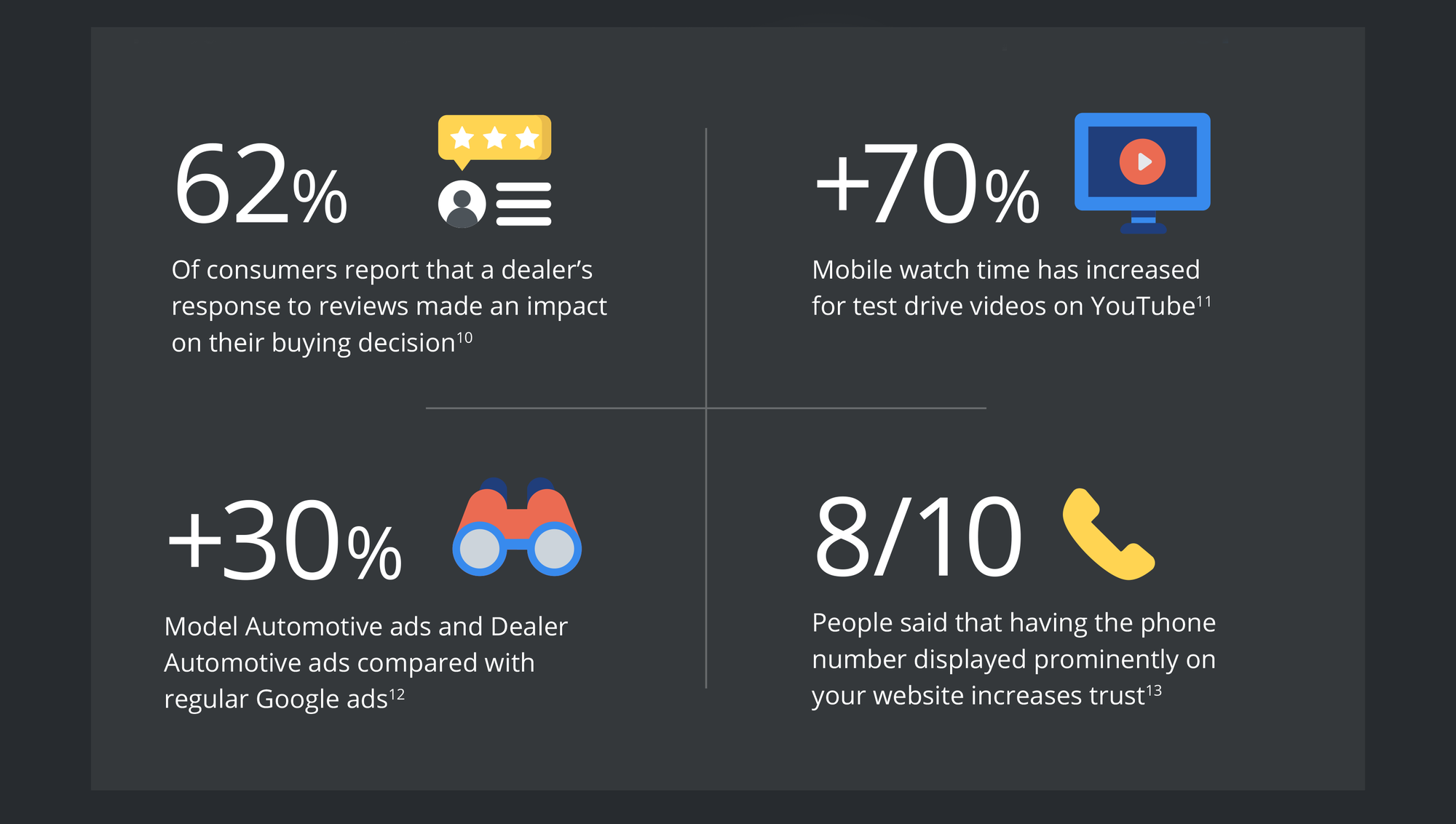Blog Highlights:
- The pandemic has forced auto dealerships to use online research tools and inbound calls as cornerstones of the new customer path to purchase.
- Instead of visiting auto lots to check out current inventory, consumers are now conducting searches from the comfort of their own homes and using their phones to schedule test drives, apply for financing, and speak to sales agents.
- Google My Business referrals soared by 61 % in the first few months of the pandemic. Auto dealerships can maximize the value of this referral pipeline by tracking referrals through dedicated call tracking numbers.
The auto sales industry has always been under pressure to efficiently field and convert sales leads while also balancing both profit margins and price negotiations with potential buyers. Now that the pandemic's safety challenges and customer concerns have restricted face-to-face interaction with car buyers, sales strategies have been forced to utilize online research tools and inbound calls as cornerstones of the new customer journey.
As consumers do more of their car shopping from home, digital engagement channels — especially inbound and outbound phone calls — have become the foundation of a successful auto sales strategy.
In our recent report analyzing call data from more than 100 million inbound calls, we uncovered some surprising insights about the current state of the automotive industry — and how dealerships can stay competitive in a fast-changing business landscape.
Here’s a look at the reasons why phone calls have risen in importance for auto sales professionals, along with insights from our research to help your sales associates make the most of this selling opportunity.
Sales agents should be ready to answer their phones
Buyers are drawn to make inbound calls to dealerships for several reasons. Many are concerned about the safety risks that come with shopping for vehicles in person.Simultaneously, some buyers are simply eager to reference online research during their call because their searches better equipped them to make informed counters during the negotiating process.
Regardless of the customers’ motivations, it’s clear that inbound calls are crucial to engaging with leads and creating sales opportunities for dealerships. Across all industries, inbound call volume had a 35% increase between June 2019 and June 2020.
Auto sales agents can leverage this sales opportunity by sticking close to their phones, answering whenever they’re available, and returning calls quickly to get connected with hot leads and offer the trusted assistance they’re looking for.
Optimize your Google My Business listing
Although overall inbound calls saw a surge in frequency once the pandemic began, inbound call rates were even higher through Google My Business (GMB) listings. From January 2020 to July 2020 — a range that stretches from before the pandemic’s arrival in the US to when rolling lockdowns were striking across the country — call referrals from this source increased by 61%.GMB has always been an important inbound referral tool for small and medium-sized businesses. Still, its role became even more prominent as consumers sought alternative ways to engage with local businesses. CallRail’s platform makes it easy to leverage GMB listings to track referrals through call tracking numbers.
Keeping your business information accurate in your GMB listing can also improve your customer experience by sharing not only your accurate hours of operation, but also additional safety disclosures, temporary closure information, and other updates relevant to today’s customers.
Make it easy for customers to take their car search online
Before the pandemic, dealerships saw a lot of new leads generated on the lot itself. Our research indicates that more than 50% of visitors to auto dealerships arrive without any prior interactions through phone, email, or other marketing channels.That means the lead pipeline has changed. Instead of browsing the inventory at a single auto lot — or spending time moving from one lot location to the next — auto buyers are browsing hundreds of car listings at dozens of dealerships. They’re identifying vehicles they’re interested in and comparing prices as they look for the best value. Because of this, they often aren’t visiting lots until they’ve narrowed their sights on a specific vehicle they’re looking to buy.
Comprehensive auto listing data can make it easier for buyers to quickly gather in-depth information about the vehicles they’re interested in. This information can range from accident histories to whether a potential vehicle offers the sunroof they’re looking for.
When buyers are interested in a vehicle, they can take various initial steps from the comfort of their own home, including scheduling a test-drive or filling out an online application for financing. They can also consult with sales agents to ask questions, negotiate on price, or handle other communications before visiting the dealership to finalize a sale.
How CallRail helps your auto sales strategy
Although a call tracking solution helps you manage, route, and prioritize inbound phone call leads, CallRail’s Form Tracking functionality can consolidate form-generated leads with inbound phone call leads to help you manage your online presence with greater efficiency.
Form tracking can connect inbound leads to specific vehicles listed on your dealership website. This lead generation tool also gathers relevant information that can help you choose an engagement strategy before reaching out (such as promoting new versus used vehicle options, or answering questions about current financing opportunities).
Meanwhile, CallRail’s Lead Center can help you track prospects throughout multiple points of engagement, interacting across phone, text form submissions, and other channels to make sure you’re keeping leads warm. Agents may have challenges tracking their leads given the increased number of leads coming from inbound calls and other sources, plus the extra work involved in returning missed calls, all while attempting to cut down response times. Lead Center helps individual agents track their sales opportunities and improve team-wide management to route new leads to available associates.
Finally, tools like Conversation Intelligence can help you optimize your auto sales strategy over time, identifying trends in consumer pain points and strengths and weaknesses in your own messaging. Even if the current surge in inbound phone referrals declines once the pandemic is over, the insights you generate from these conversations can improve your auto sales strategy for years to come.
Keep your customers’ needs dialed in
The pandemic may have changed how your dealership does business, but it hasn’t reduced your customers’ automotive needs. If anything, today’s customers are even more desperate for auto dealerships that can adjust to the current industry challenges and provide an excellent customer experience through digital channels that prioritize their safety and comfort.
See for yourself how CallRail can help your business — sign up for a 14-day free trial today.
















